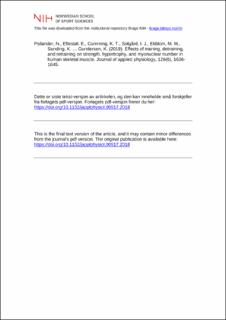| dc.contributor.author | Psilander, Niklas | |
| dc.contributor.author | Eftestøl, Einar | |
| dc.contributor.author | Cumming, Kristoffer Toldnes | |
| dc.contributor.author | Solgård, Inga Juvkam | |
| dc.contributor.author | Ekblom, Maria M. | |
| dc.contributor.author | Sunding, Kerstin | |
| dc.contributor.author | Wernbom, Mathias | |
| dc.contributor.author | Holmberg, Hans-Christer | |
| dc.contributor.author | Ekblom, Björn | |
| dc.contributor.author | Bruusgaard, Jo C. | |
| dc.contributor.author | Raastad, Truls | |
| dc.contributor.author | Gundersen, Kristian | |
| dc.date.accessioned | 2020-06-24T09:05:40Z | |
| dc.date.available | 2020-06-24T09:05:40Z | |
| dc.date.created | 2019-09-25T13:17:05Z | |
| dc.date.issued | 2019 | |
| dc.identifier.citation | Journal of applied physiology. 2019, 126(6), 1636-1645. | en_US |
| dc.identifier.issn | 8750-7587 | |
| dc.identifier.uri | https://hdl.handle.net/11250/2659258 | |
| dc.description | I Brage finner du siste tekst-versjon av artikkelen, og den kan inneholde ubetydelige forskjeller fra forlagets pdf-versjon. Forlagets pdf-versjon finner du på onlinelibrary.wiley.com / In Brage you'll find the final text version of the article, and it may contain insignificant differences from the journal's pdf version. The definitive version is available at onlinelibrary.wiley.com. | en_US |
| dc.description.abstract | Previously trained mouse muscles acquire strength and volume faster than naïve muscles; it has been suggested that this is related to increased myonuclear density. The present study aimed to determine whether a previously strength-trained leg (mem-leg) would respond better to a period of strength training than a previously untrained leg (con-leg). Nine men and 10 women performed unilateral strength training (T1) for 10 wk, followed by 20 wk of detraining (DT) and a 5-wk bilateral retraining period (T2). Muscle biopsies were taken before and after each training period and analyzed for myonuclear number, fiber volume, and cross-sectional area (CSA). Ultrasound and one repetition of maximum leg extension were performed to determine muscle thickness (MT) and strength. CSA (~17%), MT (~10%), and strength (~20%) increased during T1 in the mem-leg. However, the myonuclear number and fiber volume did not change. MT and CSA returned to baseline values during DT, but strength remained elevated (~60%), supporting previous findings of a long-lasting motor learning effect. MT and strength increased similarly in the mem-leg and con-leg during T2, whereas CSA, fiber volume, and myonuclear number remained unaffected. In conclusion, training response during T2 did not differ between the mem-leg and con-leg. However, this does not discount the existence of human muscle memory, since no increase in the number of myonuclei was detected during T1 and no clear detraining effect was observed for cell size during DT; thus, the present data did not allow for a rigorous test of the muscle memory hypothesis. | en_US |
| dc.language.iso | eng | en_US |
| dc.subject | CSA | en_US |
| dc.subject | exercise | en_US |
| dc.subject | motor learning | en_US |
| dc.subject | muscle memory | en_US |
| dc.subject | myonuclei | en_US |
| dc.title | Effects of training, detraining, and retraining on strength, hypertrophy, and myonuclear number in human skeletal muscle | en_US |
| dc.type | Peer reviewed | en_US |
| dc.type | Journal article | en_US |
| dc.description.version | acceptedVersion | en_US |
| dc.source.pagenumber | 1636-1645 | en_US |
| dc.source.volume | 126 | en_US |
| dc.source.journal | Journal of applied physiology | en_US |
| dc.source.issue | 6 | en_US |
| dc.identifier.doi | 10.1152/japplphysiol.00917.2018 | |
| dc.identifier.cristin | 1728886 | |
| dc.relation.project | Norges forskningsråd: 240374 | en_US |
| dc.description.localcode | Seksjon for fysisk prestasjonsevne / Department of Physical Performance | en_US |
| cristin.ispublished | true | |
| cristin.fulltext | original | |
| cristin.fulltext | postprint | |
| cristin.qualitycode | 1 | |
